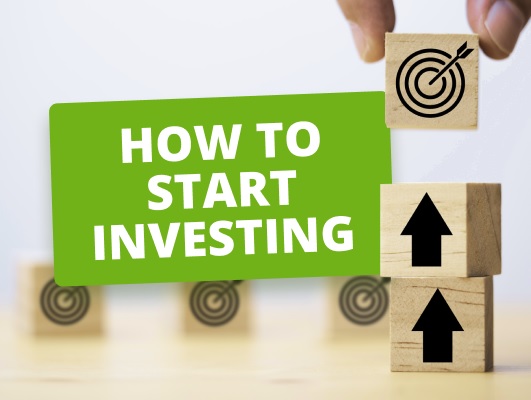A Step-by-Step Guide to Building Your First Investment Portfolio
 Building your first investment portfolio can feel like a daunting task, but with a clear plan and the right guidance, it can be an exciting and rewarding experience. Whether you’re aiming to save for retirement, a home, or simply grow your wealth, understanding how to allocate your investments wisely is crucial. In this guide, we’ll walk you through the process, step by step, to create a diversified and balanced portfolio tailored to your financial goals.
Building your first investment portfolio can feel like a daunting task, but with a clear plan and the right guidance, it can be an exciting and rewarding experience. Whether you’re aiming to save for retirement, a home, or simply grow your wealth, understanding how to allocate your investments wisely is crucial. In this guide, we’ll walk you through the process, step by step, to create a diversified and balanced portfolio tailored to your financial goals.
Step 1: Understand Your Financial Goals
Before you even start choosing investments, it’s essential to know what you’re investing for. Are you saving for retirement, a major purchase, or just trying to grow your wealth? Your financial goals will dictate your investment strategy and risk tolerance.
Key Questions to Ask:
- What is your investment time horizon? (Short-term vs. long-term)
- Do you have any specific goals or milestones you’re working toward?
- Are you building an emergency fund as well?
Step 2: Assess Your Risk Tolerance
Everyone has a different level of comfort when it comes to risk. Your risk tolerance refers to the amount of uncertainty you’re willing to accept in your investment returns. If you’re just starting out, it’s important to understand that investments can go up and down, and you’ll need to decide how much volatility you’re comfortable with.
Factors to Consider:
- Age: Younger investors can typically handle more risk because they have more time to recover from market downturns.
- Financial Situation: Do you have any debt or large financial obligations? A secure income may allow you to take on more risk.
- Emotional Comfort: Some people can’t handle the stress of seeing their portfolio fluctuate, while others find it exciting.
Step 3: Diversify Your Portfolio
Diversification is one of the most important principles in investing. By spreading your investments across different asset classes (stocks, bonds, real estate, etc.), you reduce the risk of significant losses. If one investment performs poorly, the others may perform better and balance out the overall risk.
Key Asset Classes to Consider:
- Stocks: Equities, or stocks, offer high potential returns, but they can also be volatile. Consider a mix of large-cap, mid-cap, and small-cap stocks, or invest in index funds that track a broad market index.
- Bonds: Bonds are generally more stable than stocks and can offer a steady stream of income. They are an excellent way to balance out the risk in your portfolio.
- Real Estate: Real estate investments, through either direct property ownership or real estate investment trusts (REITs), can provide both income and long-term growth.
- Cash or Cash Equivalents: Keep a portion in liquid, low-risk investments like money market funds or savings accounts to act as a safety net.
Step 4: Choose Your Investment Accounts
The type of investment account you use can have a significant impact on your taxes and long-term growth. There are several types of accounts available, each with its own set of benefits.
Common Investment Accounts:
- Tax-Advantaged Accounts: These accounts offer tax benefits, such as IRAs or 401(k)s. They are ideal for retirement savings as you can either defer taxes (traditional IRA) or take tax-free withdrawals in retirement (Roth IRA).
- Taxable Brokerage Accounts: If you’re investing outside of retirement, you’ll likely use a taxable brokerage account. While it doesn’t offer the same tax benefits, it gives you more flexibility with your money.
Step 5: Decide on a Strategy
There are various investment strategies you can use to grow your portfolio. You’ll need to decide which strategy aligns best with your risk tolerance and time horizon.
Common Investment Strategies:
- Buy and Hold: This strategy involves purchasing investments with the intention of holding them long-term, allowing you to ride out market fluctuations.
- Dollar-Cost Averaging (DCA): DCA involves investing a fixed amount of money at regular intervals, regardless of the market’s performance. This strategy helps you avoid trying to time the market.
- Value Investing: This strategy involves looking for undervalued assets that are priced below their intrinsic value, with the expectation that they will rise in value over time.
Step 6: Select Individual Investments or Funds
Now it’s time to choose specific investments. You can invest in individual stocks or bonds, or you can use investment funds to create a more diversified portfolio.
Individual Stocks vs. Funds:
- Individual Stocks: If you have the time and expertise, you can research and choose individual stocks to add to your portfolio. However, this requires a lot of knowledge and can be risky without diversification.
- Index Funds and ETFs: If you’re new to investing, consider index funds or exchange-traded funds (ETFs). These funds track a specific index, such as the S&P 500, and provide instant diversification.
Step 7: Rebalance Your Portfolio Regularly
Once your portfolio is set up, it’s important to monitor and rebalance it regularly to ensure it aligns with your financial goals. Over time, some investments will perform better than others, causing your portfolio to become unbalanced.
How to Rebalance:
- Review your portfolio every 6-12 months.
- If one asset class has outperformed others, you may need to sell some of those investments and invest in other areas to return to your desired asset allocation.
Step 8: Stay Disciplined and Patient
Investing is a long-term game. It’s easy to get tempted by short-term market fluctuations, but it’s important to stay disciplined and focused on your goals. Patience is key, and consistently contributing to your portfolio will help it grow over time.
Tips for Success:
- Avoid making emotional decisions based on short-term market movements.
- Stay informed about market trends but don’t obsess over daily fluctuations.
- Be prepared to adjust your strategy as your life circumstances or goals change.
Conclusion
Building your first investment portfolio doesn’t have to be overwhelming. By understanding your goals, assessing your risk tolerance, diversifying your investments, and staying disciplined, you can start building a portfolio that works for you. Remember, investing is a marathon, not a sprint, and with time and consistency, your portfolio can grow to help you achieve your financial dreams.



